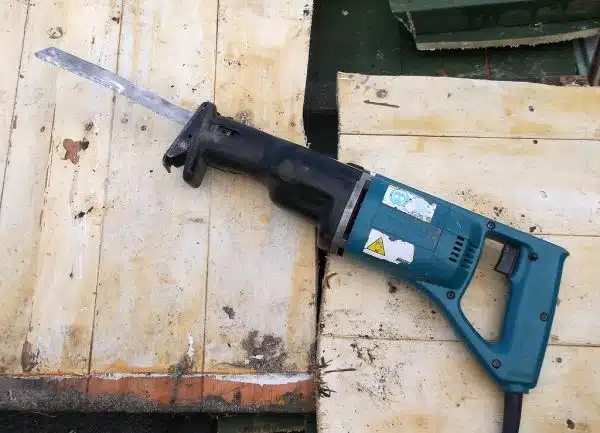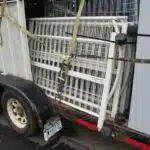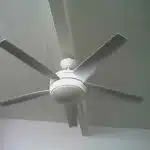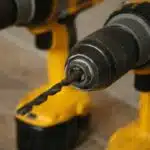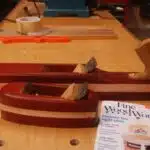As a professional carpenter, the reciprocating saw is one of the most important tools in my arsenal. This versatile tool can cut through a variety of materials including wood, metal, and plastics. Whether you are a DIY enthusiast or a professional builder, learning how to use a reciprocating saw can save you time and effort on your projects.
In this article, we will cover the basics of using a reciprocating saw. We will discuss the different types of blades available and which ones are best for specific cutting tasks. Additionally, we will provide tips on how to safely operate the tool and avoid common mistakes that can lead to injury or damage to your project. By following these guidelines, you will be able to confidently and effectively use a reciprocating saw on your next project.
Understanding The Components Of A Reciprocating Saw
When working with a reciprocating saw, it is important to first understand the different components that make up the tool. The key parts of a reciprocating saw include the motor, blade clamp, blade release, shoe, and handle. The motor is responsible for powering the saw’s back-and-forth motion, while the blade clamp is used to secure the blade in place during use.
Proper care and maintenance of a reciprocating saw is crucial for ensuring its longevity and optimal performance. Before using the tool, it is important to inspect all parts for damage or wear and tear. Additionally, keeping the tool clean and free of debris can prevent damage to its internal components.
By identifying the key parts of a reciprocating saw and practicing proper care and maintenance techniques, users can ensure safe operation of this powerful cutting tool. In the next section, we will discuss different types of reciprocating saw blades and how to choose the right one for your specific project needs.
Types Of Reciprocating Saw Blades
Like the teeth of a saw, the blade is the most essential component of a reciprocating saw. Blade selection is critical in achieving high-quality cuts and productivity. Reciprocating saw blades come in various shapes, sizes, and materials to handle different cutting applications.
The cutting speed of a reciprocating saw blade depends on several factors such as its length, teeth per inch (TPI), and the material it is designed to cut. The longer the blade, the faster it can cut through thicker materials. Blades with lower TPI are ideal for cutting wood or other soft materials, while those with higher TPI are perfect for metal-cutting applications.
Choosing the right blade for your project can be daunting, but it is crucial to ensure you get the best results. Consider factors such as the type of material you intend to cut, its thickness, and whether you require straight or curved cuts. With these considerations in mind, you can select a suitable blade that will provide clean cuts and increase your productivity.
Choosing The Right Blade For Your Project
After learning about the different types of reciprocating saw blades, it’s crucial to choose the right blade for your project. Blade selection tips include considering the material you’ll be cutting through, the thickness of the material, and any curves or angles in your cut. A few other factors to consider when choosing a blade are its teeth-per-inch (TPI) count, tooth shape, and blade length.
Cutting through different materials requires different types of blades. For example, wood blades have wider teeth and fewer TPIs than metal blades, which have smaller teeth and more TPIs. Additionally, some blades are designed specifically for cutting through materials like drywall or nails. It’s important to select a blade that matches both the type and thickness of your workpiece for optimal results.
Choosing the right blade can make all the difference in achieving precise cuts and avoiding damage to your tool or workpiece. By following these blade selection tips and considering the material you’ll be cutting through, you can ensure that you’re using a blade that’s appropriate for your project and will produce clean cuts with minimal effort and damage to your tool. Next up is preparing your workpiece for cutting – an essential step before starting any sawing task.
Preparing Your Workpiece For Cutting
- When preparing a workpiece for cutting, it is essential to mark out cutting lines accurately in order to ensure a precise cut.
- Securing the workpiece is paramount to ensure stability and safety during the cutting process.
- The use of clamps, vises, and other tools can be used to help keep the workpiece steady and secure.
- Additionally, using a reciprocating saw with a proper blade type can ensure that the job is done quickly and efficiently.
Marking Out Cutting Lines
Achieving precision in cutting is an essential aspect of carpentry. Therefore, marking out cutting lines accurately is a crucial step in preparing your workpiece for the reciprocating saw. Measuring accuracy cannot be overemphasized when it comes to this process. An error in measurement could result in costly mistakes that may ruin the workpiece and waste time.
To ensure precision, it’s best to use common marking tools like pencils, rulers, and squares. A pencil is ideal for marking out a line because it can be easily erased or corrected if there are errors. A ruler helps measure the distance between two points accurately while a square ensures that angles are perfectly perpendicular. It’s important to note that taking your time during this process will save you time and energy in the long run.
In conclusion, before using a reciprocating saw on your workpiece, proper preparation should be done by marking out cutting lines with accuracy. This process requires the use of common marking tools such as pencils, rulers, and squares. Taking your time and ensuring measuring accuracy is key to achieving precise cuts with your reciprocating saw.
Securing Workpiece
Preparing your workpiece for cutting involves several crucial steps that carpenters must follow to ensure precision and accuracy. One of these essential steps is securing the workpiece. Proper clamping methods ensure that the workpiece remains stable during the cutting process, preventing it from moving or vibrating excessively, which can lead to inaccurate cuts or personal injury.
There are various clamping methods available when securing a workpiece. The choice of clamping method will depend on the size, shape, and material of the workpiece. For smaller pieces, a bench vise may be sufficient, while larger pieces may require specialized clamps or jigs. It’s important to note that proper clamping ensures that you have control over the workpiece while using the reciprocating saw.
Workpiece stability is also crucial in achieving precise cuts with a reciprocating saw. If the workpiece moves or vibrates excessively during cutting, it can result in jagged edges and uneven cuts. Additionally, unstable workpieces can be dangerous as they may cause physical harm to the carpenter using the saw. Therefore, ensuring proper clamping methods and maintaining workpiece stability should always be prioritized when preparing for cutting with a reciprocating saw.
Basic Cutting Techniques
Using a reciprocating saw can be an intimidating task, but with practice and the right technique, anyone can master it. One of the most important aspects of using a reciprocating saw is blade selection. Different blades are designed for different materials, so it is crucial to choose the right blade for the job. For instance, if you’re cutting through wood or plastic, use a fine-toothed blade; for metal or fiberglass, use a coarse-toothed blade.
Another critical factor to consider when using a reciprocating saw is cutting angles. The angle at which you hold the saw determines how straight your cut will be. To make a straight cut, hold the saw perpendicular to the material you’re cutting. On the other hand, to make angled cuts, tilt the saw slightly in the direction you want to cut. It is essential to keep both hands on the tool while cutting and maintain firm pressure on it.
Mastering these basic techniques will help you achieve accurate and clean cuts with your reciprocating saw. In addition to these basic techniques, there are more advanced cutting techniques that you can incorporate into your workflow. These include plunge cuts, bevel cuts, and flush cuts. We’ll explore these advanced techniques in detail in the subsequent section, helping you take your skills to the next level and tackle more complex projects with ease.
Advanced Cutting Techniques
Making straight cuts with a reciprocating saw requires accuracy and a steady hand. To ensure a clean cut, ensure the saw is set to the proper speed and the blade is sharp and in good condition. Cutting curves with a reciprocating saw requires the use of a jigsaw blade and a slower speed setting. When cutting thicker materials, use a solid-body blade, as it is designed to cut through thicker materials without bending or breaking. When cutting thick materials, it is important to make sure the saw is set to the correct speed, and that the blade is in good condition and sharp. Additionally, using a guide can help make the cut more accurate. Finally, when cutting thick materials, it is best to take your time and make sure the cut is clean.
Making Straight Cuts
When it comes to using a reciprocating saw, making straight cuts is an essential technique for any carpenter. To achieve this, one must ensure that the blade is properly aligned with the cutting line before starting. Additionally, securing the material being cut with clamps or vice grips can help to maintain stability and prevent unwanted movement during the cutting process.
Techniques for curved cuts may differ from those used for straight cuts. For example, when cutting curves, it’s important to keep the blade at a consistent angle throughout the cut to avoid jagged edges or uneven surfaces. This can be accomplished by allowing the saw’s natural oscillation to guide the blade as it moves along the curve.
Finally, when faced with thicker materials such as metal or dense wood, there are several tips for cutting that can make the job easier and more efficient. One such tip is to use a longer blade which will allow for deeper cuts and better control. Another option is to adjust the speed of your reciprocating saw; slowing down can help you maintain accuracy and precision while also reducing vibrations that might cause fatigue or discomfort over time.
Ultimately, mastering advanced cutting techniques like making straight cuts requires both practice and patience but with time and experience, anyone can learn how to use a reciprocating saw like a professional carpenter.
Cutting Curves
When it comes to advanced cutting techniques, learning how to cut curves is an important skill for any carpenter. Unlike straight cuts, cutting curves requires a different approach and technique. One of the key factors in achieving a smooth curve is choosing the right blade for the job. A blade that is too coarse can result in rough edges, while a blade that is too fine can cause excessive heat and wear on the saw.
In addition to choosing the right blade, adjusting the speed of your reciprocating saw can also be beneficial when cutting curves. Slowing down the speed of your saw can help you maintain better control and precision while making curved cuts. Keeping a consistent angle throughout the cut is also crucial, as this helps prevent jagged edges or uneven surfaces.
Overall, mastering advanced cutting techniques like making curved cuts with a reciprocating saw requires practice and attention to detail. By selecting the appropriate blade for your project and adjusting your saw’s speed accordingly, you can achieve smooth curves that will enhance the overall quality of your workmanship.
Cutting Thick Materials
Advanced cutting techniques are essential for a professional carpenter to achieve precise and high-quality cuts. One of the challenging tasks that carpenters may encounter is cutting thick materials. Cutting angles and curves in thick materials such as hardwoods, metals, or plastics require a different approach than cutting through thinner materials. It is crucial to have the right blade and tools to avoid blade wear, overheating, or even damage to the saw.
When it comes to cutting thick materials, selecting the appropriate blade can make a significant difference in achieving clean cuts. A carbide-tipped blade with large teeth is ideal for cutting through hardwoods while maintaining accuracy and precision when making angled or curved cuts. The carbide tips prevent dulling of the blade while maintaining sharpness over time, which makes it an excellent investment for any professional carpenter.
Finally, using a slow speed setting on your reciprocating saw when tackling thicker materials will help you maintain better control throughout the cut. This technique allows you to manage the saw’s movements more efficiently while keeping your hands steady for consistent results. With these advanced cutting techniques and appropriate tools at hand, carpenters can produce exceptional workmanship that meets their customers’ expectations every time.
Safety Precautions And Gear
It is often said that “safety first” should be the guiding principle of any task, and this is certainly true when using a reciprocating saw. Despite its usefulness in various cutting applications, it can also pose significant risks if not used properly. As such, it is crucial to take safety precautions seriously and wear the appropriate gear.
One of the most important things to keep in mind when handling a reciprocating saw is proper grip. A firm hold on the tool can help prevent it from slipping or jerking unexpectedly, which can lead to serious injury. It is also essential to use both hands when operating the saw – one on the trigger and the other on the handle – for greater control and stability.
Another key aspect to consider when using a reciprocating saw is adjusting blade speed. Different blades are designed for specific tasks and materials, so it’s crucial to choose the right one and set its speed accordingly. Failure to do so may result in damage to both the blade and tool, as well as potential harm to yourself or others nearby.
In summary, taking safety precautions seriously is vital when using a reciprocating saw. Always wear protective gear like eye goggles, gloves, and earplugs when necessary, ensure proper grip at all times with both hands on the tool for better control, and adjust blade speeds according to task requirements. With these measures in place, you can work confidently and avoid accidents that might otherwise occur due to carelessness or lack of attention.
- Wear protective gear such as eye goggles, gloves, earplugs.
- Use both hands when handling the tool.
- Choose correct blade type based on task requirements.
- Adjust blade speed accordingly before use.
The Importance of Proper Grip and How to Adjust Blade Speed are just two vital aspects of safely using a reciprocating saw; however, there are still many common mistakes that people make that can lead to injury or damage. In the next section, we’ll discuss some of these errors and how to avoid them.
Common Mistakes To Avoid
When using a reciprocating saw, there are some common mistakes that beginners often make. The first mistake is choosing the wrong blade for the job. It’s important to select a blade that is suitable for the material you will be cutting. Using the wrong blade can result in a poor cut or even damage to the saw. Before starting any project, take time to research and select the appropriate blade.
Another common mistake is an improper grip on the saw. When holding the saw, it’s essential to have a firm grip with both hands and keep your fingers away from the blade. Failure to hold it properly can lead to accidents, including cuts, broken bones, or even amputations. Always ensure that you have a good grip on your reciprocating saw before beginning any task.
For beginners, starting and stopping can also be tricky. To start your reciprocating saw, press down lightly on the trigger until it starts moving slowly. Once it begins moving, gradually increase pressure until you reach your desired speed level. To stop your saw safely, release pressure on the trigger and wait for it to come to a complete stop before setting it down and turning off power supply. Adjusting speed is also something that takes time and practice – start slow until you feel comfortable with increasing speed.
In conclusion of this section about common mistakes to avoid when using a reciprocating saw, remember these tips: always choose proper blades for each project; maintain a firm grip while handling; start slowly and increase speed gradually; stop carefully by releasing pressure then wait for complete stop before setting down tool & turning off power supply. In order to continue working safely with your reciprocating saw over its lifetime of use we need focus next on how maintaining your reciprocating saw properly which will help prevent accidents or damage occurring due lack of maintenance!
Maintaining Your Reciprocating Saw
After learning about the common mistakes to avoid when using a reciprocating saw, it is important to know how to properly maintain your tool. This will not only help prolong its lifespan but also ensure that it works efficiently every time you need it. Two essential maintenance practices are cleaning and lubrication.
Cleaning techniques vary depending on the type of saw and the amount of debris accumulated. A brush or compressed air can be used to remove dust and small particles from the exterior and interior components of the saw. For tougher stains, a rag dipped in solvent or rubbing alcohol can be used. It is important not to use water as this can lead to rusting. Always remember to unplug your saw before cleaning it.
Lubrication methods involve applying oil or grease onto moving parts such as the blade holder and gears. This helps reduce friction which can cause overheating and premature wear and tear. Refer to your manufacturer’s instructions for specific lubricants recommended for your saw model. Over-lubricating can lead to accumulation of dirt which interferes with proper functioning of parts, so apply just enough oil or grease as required.
Moving on from maintaining your reciprocating saw, knowing how to troubleshoot any issues that arise is equally important.
Troubleshooting Tips
When it comes to using a reciprocating saw, there are times when the saw may not work as it should. In these situations, knowing how to troubleshoot the problem will save you time and frustration. As the saying goes, “an ounce of prevention is worth a pound of cure.”
Fixing malfunctioning saws can be as simple as checking the power source or changing the blade. Make sure that your power cord is securely plugged into an outlet and that there are no frayed wires. If your saw still does not turn on, try plugging it into another outlet. If your blade is dull or broken, replacing it with a new one can make a world of difference.
Maximizing saw performance requires proper maintenance. Clean your saw regularly and lubricate moving parts with oil or grease. Check that all screws and bolts are tight and in good condition. A well-maintained tool will last longer and perform better than one that has been neglected.
- Here are five tips to keep your reciprocating saw in top shape:
- Store it in a dry place to prevent rust.
- Use safety glasses and gloves when working with the tool.
- Avoid forcing the blade through tough materials.
- Let the blade cool down between uses to prevent overheating.
- Check for loose screws before each use.
By following these simple troubleshooting steps and maintenance techniques, you can ensure that your reciprocating saw is always ready for action. In the next section, we will discuss how to use a reciprocating saw for demolition without damaging surrounding areas or injuring yourself or others.
Using A Reciprocating Saw For Demolition
When it comes to demolition work, the reciprocating saw is a powerful and versatile tool. However, safety should always be a top priority when using this type of equipment. Before starting any demolition work, it’s essential to review and follow all manufacturer instructions carefully. Proper safety gear such as gloves, goggles, ear protection, and respiratory masks should also be used.
One of the most efficient techniques for using a reciprocating saw during demolition is to start from the top and work your way down. This strategy means that you can take advantage of gravity to help pull down materials while minimizing the risk of injury due to falling debris. Additionally, it’s often best to use a variety of blade types depending on the material being cut. For example, a bi-metal blade may be ideal for cutting through metal while a wood-cutting blade may be better suited for lumber.
In summary, using a reciprocating saw for demolition requires careful attention to safety precautions and efficient techniques. By starting from the top and working your way down while using appropriate blade types for different materials, you can maximize efficiency while minimizing risks. Whether you’re tearing down drywall or demolishing an entire room, following these guidelines will help ensure that you complete the job safely and effectively.
As we move on to discussing how to use a reciprocating saw for plumbing applications, remember that safety should still be your top priority. While plumbing work may not involve as much demolition as other tasks do, there are still risks associated with operating power tools in tight spaces around water pipes and fittings. With proper safety measures in place, however, you can confidently tackle plumbing projects with ease.
Using A Reciprocating Saw For Plumbing
A reciprocating saw is an essential tool in your toolkit when it comes to plumbing renovations. It can cut through various materials, including wood, metal, and plastic. However, before using the saw, you must ensure that you have the appropriate blade for the material you will be cutting.
When using a reciprocating saw for bathroom renovation, safety should always be your top priority. Wear protective gear such as gloves and eyewear to prevent debris from entering your eyes or cutting your hands. Additionally, make sure that the workpiece is securely clamped down before beginning to cut.
Tips for cutting through PVC pipes with a reciprocating saw include starting at a slow speed until you get comfortable with the tool’s operation and then gradually increasing the speed. Also, it’s best to use short strokes as they produce less heat and reduce the risk of melting or warping the pipe. Finally, keep the blade parallel to the pipe for a clean, straight cut.
Next up is using a reciprocating saw for electrical work. While similar in some aspects to plumbing work, there are different considerations to keep in mind when working on electrical projects.
Using A Reciprocating Saw For Electrical Work
When utilizing a reciprocating saw for electrical work, it is important to select the appropriate blade for the job. The teeth per inch (TPI) of the blade should correspond to the material being cut, with fewer teeth per inch for harder materials such as metal and more teeth per inch for softer materials such as plastic. For precise cuts, it is important to allow the blade to do the work by applying moderate pressure to the saw. To maximize safety while working, it is important that the saw is connected to the appropriate power supply and that the power is switched off when making adjustments to the saw or blades.
Selecting Appropriate Blades
For any carpenter, selecting the appropriate blade for a reciprocating saw is of paramount importance. A wrong choice could result in inadequate precision and safety hazards. Blade selection tips are essential, and it is crucial to understand the compatibility of the blade with materials that will be cut. For instance, if you are cutting through metal, choose a bi-metal blade that can withstand heat buildup and last longer.
One needs to consider other factors when selecting an appropriate blade for electrical work. The thickness of the material being cut should be considered since blades come in different lengths and widths. If you need to make delicate cuts, select a thinner blade that provides more control over your cutting process. Another factor to take into account is the type of electrical equipment being worked on; for example, thin blades are ideal for working around small wires while thicker ones suit larger cables.
Blade compatibility with materials goes beyond just knowing what material you’ll be cutting through but also understanding if the blade can handle various applications. Ensure that your chosen blade has teeth per inch (TPI) appropriate for the job at hand; fewer TPIs mean faster cuts while more TPIs offer smoother finishes but slower cuts. Knowing how to select the right blades is critical as it allows you to achieve optimal results in less time without compromising quality or safety concerns.
Cutting Precisely
Precision is critical when using a reciprocating saw for electrical work. Electrical components are delicate, and cutting them requires precision cutting techniques that can only be achieved with the right blade and control over the speed of the blade. Controlling the speed of the blade is essential in achieving precise cuts as too much speed can result in rough edges, while too little speed will not cut through the material. As a professional carpenter, I have learned that to achieve precision cuts, you must practice proper technique and use specific blades suited for different materials.
One tip for controlling blade speed is to avoid forcing the blade into the material being cut. Instead, let the blade do its job by applying light pressure on it as you guide it through the material. The use of a variable-speed trigger helps in controlling the speed of the blade as well. It allows one to increase or decrease the cutting speed depending on the thickness of the material being cut. Using a slower speed when starting a cut gives you more control over your tool, ensuring straighter cuts.
Another tip for achieving precision cuts is selecting an appropriate blade with smaller teeth per inch (TPI). A smaller TPI means slower but smoother cuts that result in cleaner edges with less tear-out. Blades with higher TPI are ideal if you want faster cuts but may cause chipping or leave rough edges on your workpiece. As a carpenter, I know how important it is to choose blades that work best with specific materials and applications to achieve optimal results in less time without compromising quality or safety concerns.
In conclusion, using a reciprocating saw for electrical work requires precision cutting techniques and tips for controlling blade speed. By choosing an appropriate blade suited for specific materials and applications, practicing proper technique, and controlling blade speed through light pressure application and variable-speed trigger use, one can achieve accurate cuts without compromising safety concerns or quality output.
Power Supply Safety
When working with a reciprocating saw for electrical work, it is essential to ensure power supply safety. As a professional carpenter, I know the importance of maintaining the power supply system to avoid potential hazards that can cause serious injuries or damage to property. Power supply maintenance entails ensuring that electrical circuits are safe and secure before starting any cutting operation.
One critical aspect of power supply safety when using a reciprocating saw is to ensure that the tool’s power cord does not come into contact with any electrical wires or circuitry. If this happens, the circuit breaker can trip, causing damage to the saw or worse, an electric shock hazard. Therefore, it is necessary to route the cord away from any electrical components and keep it taut throughout the cutting process.
Additionally, it is crucial to inspect all electrical connections before starting work. Loose connections and wires can cause sparks and short-circuits leading to hazardous situations. Inspections should be carried out regularly as part of a pre-work routine. In conclusion, Power supply safety is a critical aspect of using a reciprocating saw for electrical work. By maintaining the power supply system and checking all connections before starting work, one can avoid potential hazards and ensure safe operation throughout the cutting process.
Using A Reciprocating Saw For Metal Cutting
When it comes to metal cutting techniques, a reciprocating saw can be a versatile tool. However, the type of blade used will depend on the thickness and hardness of the metal being cut. For thinner metals such as sheet metal or aluminum, a fine-toothed blade with at least 18 teeth per inch is recommended. For thicker metals such as steel or iron, a coarse blade with fewer teeth per inch is necessary.
Before beginning any cuts, make sure to secure the metal firmly in place using clamps or a vise. This will prevent the metal from moving and potentially causing injury. It’s also important to wear proper eye and ear protection while operating the saw.
When making cuts, start slow and gradually increase speed as needed. Let the weight of the saw do most of the work and avoid applying excessive force which may damage both the blade and saw. Remember to periodically check the blade for signs of wear or damage and replace it as necessary.
Moving onto woodworking, using a reciprocating saw for this purpose requires different techniques than metal cutting. In particular, selecting an appropriate blade for wood cutting is important to get smooth cuts with minimal splintering. In addition to standard blades, there are specialized blades designed for specific tasks such as pruning trees or cutting through nails in reclaimed wood. Proper technique combined with selecting the right blade can turn a reciprocating saw into an invaluable tool for carpentry projects.
Using A Reciprocating Saw For Woodworking
After mastering the art of metal cutting using a reciprocating saw, it’s time to move on to woodworking applications. I know what you’re thinking, “how hard can it be? It’s just wood!” Well, my friend, don’t underestimate the power of this tool. While it may seem simple enough, improper use can lead to serious injury or damage to your project.
To ensure safety while using a reciprocating saw for woodworking applications, there are some guidelines that must be followed. First and foremost, always wear protective gear such as safety glasses and gloves. Make sure the blade is appropriate for the type of wood you are cutting and adjust the speed accordingly. Keep your work area clean and free of debris to avoid tripping hazards.
Now that we’ve covered safety guidelines, let’s talk about some practical tips for using a reciprocating saw in woodworking applications. When making long cuts in large pieces of wood, use a straight edge or guide to keep your cut straight and even. For intricate cuts or curves, try using a smaller blade with a higher TPI (teeth per inch) count. And remember to take breaks frequently to avoid fatigue and maintain accuracy.
- Always wear protective gear
- Choose appropriate blades for the type of wood being cut
- Keep work area clean and free of debris
- Take frequent breaks
As a professional carpenter, my priority is not only creating beautiful pieces but also ensuring the safety of myself and others around me. By following these guidelines and practical tips when using a reciprocating saw for woodworking applications, you can achieve both objectives successfully. Remember to respect the power of this tool and treat it with care so that you can enjoy its benefits for years to come!
Conclusion
The reciprocating saw is a powerful tool that can be used to cut through a variety of materials, including wood, metal, and plastic. However, using this tool requires knowledge of its different components and blade types, as well as proper preparation and cutting techniques.
Before using a reciprocating saw, it is important to understand the various parts that make up the tool, such as the motor, blade clamp, and trigger switch. In addition, choosing the right type of blade for your project will ensure that you achieve clean cuts without damaging your workpiece.
Once you have familiarized yourself with these basics, you can begin preparing your workpiece for cutting by marking your desired cut line and securing it in place. From there, you can use basic cutting techniques to make precise cuts through a variety of materials.
Whether you are using a reciprocating saw for plumbing or electrical work or woodworking tasks like demolition or rough framing, understanding its various uses and capabilities will allow you to complete your projects quickly and efficiently. By following these guidelines and practicing safe usage habits at all times, you can become an expert in using the reciprocating saw like a professional carpenter. With time and practice, your skills will develop until handling this powerful tool becomes second nature.
Image Credits
- “Reciprocating saw” by Phil_Parker (featured)

